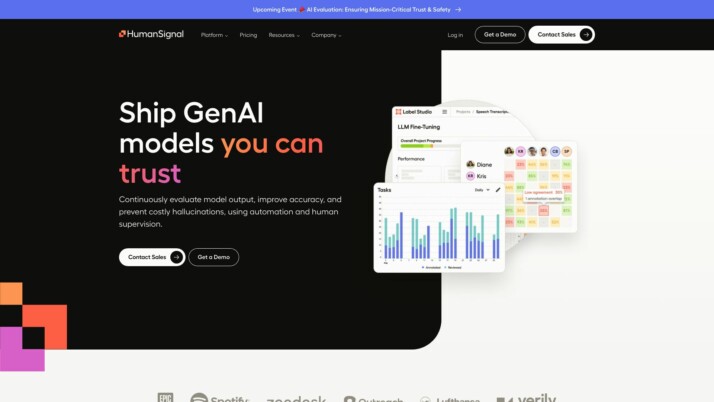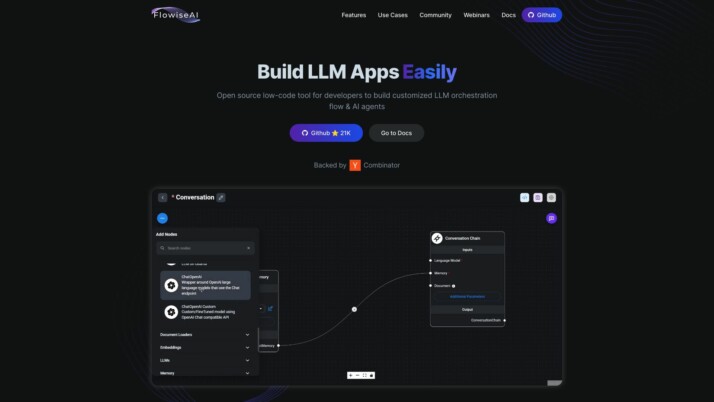Adala vs. FlowiseAI: Feature Comparison
As the AI ecosystem continues to mature and expand at an astonishing rate, discerning professionals are seeking powerful yet accessible solutions to harness the transformative potential of this game-changing technology. This comprehensive guide delves into the capabilities of three prominent platforms, Adala vs. FlowiseAI, and SmythOS, equipping you with the insights needed to make an informed decision aligning with your unique requirements.
Join us on an exploration of the cutting-edge features, use cases, and utility offered by each tool, empowering you to navigate the ever-evolving AI landscape with confidence.
Adala Overview
Adala is an open-source framework for building autonomous data labeling agents. It allows users to create intelligent agents capable of acquiring specialized skills like text classification, summarization, and question answering through interactions with data and human feedback.
Utilizing large language models like GPT-3 as the core runtime, Adala enables the development of AI agents that can continuously improve their capabilities. The framework employs a modular architecture with extensible components for skills, datasets, and environments, encouraging community-driven enhancements.


Adala’s vision is to increase efficiency and reduce costs associated with data labeling tasks while maintaining high accuracy through human guidance. Its agents learn from labeled ground truth datasets provided by users, allowing them to refine their skills through an iterative feedback loop that ensures reliable performance.
FlowiseAI Overview
FlowiseAI is an open-source, low-code platform designed to help developers create customized large language model (LLM) orchestration flows and AI agents. Its visual, drag-and-drop interface simplifies the process of building sophisticated applications that leverage advanced AI models.
FlowiseAI stands out for its integration capabilities, allowing developers to connect various data sources, vector databases, and LLMs in modular workflows. This makes it versatile for a wide range of use cases, such as document analysis, question answering, and customer support.
One of the platform’s unique features is its agent and chain system, where developers can link different components (e.g., document loaders, text splitters, LLMs) to create complex AI processes. This modular approach streamlines the development and management of AI applications.


FlowiseAI aims to democratize AI development by providing an accessible, open-source platform that lowers the barrier to entry. Its vision is to make building AI applications as straightforward as creating a website, empowering a broader audience to leverage the power of large language models.
Feature Comparison
While Adala and FlowiseAI share some fundamental capabilities as AI agent builders, there are notable differences in their feature sets and approaches.
Adala’s strength lies in its specialization for data labeling tasks. Its modular architecture allows users to create autonomous agents that can acquire skills like text classification, summarization, and question answering through interactions with data and human feedback. However, Adala lacks features like a visual builder, hosted environments, and support for multimodal data, limiting its accessibility and versatility compared to FlowiseAI.
Adala’s strength lies in its specialization for data labeling tasks.
On the other hand, FlowiseAI stands out as a low-code platform with a drag-and-drop visual interface, making it more user-friendly for non-technical users. It supports a wide range of AI models, APIs, and data sources, including multimodal inputs like images and PDFs. FlowiseAI also offers deployment options like APIs, webhooks, and chatbots, providing greater flexibility in integrating AI agents with existing systems.
While Adala focuses on iterative learning and human feedback for refining its agents, FlowiseAI emphasizes features like autonomous agents, explainability, and scalability, making it better suited for production-level deployments and complex problem-solving scenarios.
FlowiseAI stands out as a low-code platform with a drag-and-drop visual interface, making it more user-friendly for non-technical users.
In terms of security and compliance, FlowiseAI includes data encryption, which is not explicitly mentioned in Adala’s documentation. However, Adala appears to prioritize constrained alignment, ensuring its agents operate within predefined boundaries, which is not explicitly covered in FlowiseAI’s features.
Overall, Adala excels in its niche as a data labeling framework, while FlowiseAI offers a more comprehensive and accessible platform for building and deploying AI agents across a wide range of use cases and industries.
Feature Comparison Table
| Adala | FlowiseAI | SmythOS | |
|---|---|---|---|
| CORE FEATURES | |||
| Autonomous Agents | ❌ | ✅ | ✅ |
| Explainability & Transparency | ❌ | ✅ | ✅ |
| Multimodal | ❌ | ✅ | ✅ |
| SECURITY | |||
| Data Encryption | ❌ | ✅ | ✅ |
| COMPONENTS | |||
| Huggingface AIs | ❌ | ❌ | ✅ |
| Logic | ❌ | ✅ | ✅ |
| DEPLOYMENT OPTIONS | |||
| Deploy as API | ❌ | ❌ | ✅ |
| API Authentication (OAuth + Key) | ❌ | ✅ | ✅ |
| Scalability | ❌ | ✅ | ✅ |
| DATA LAKE SUPPORT | |||
| URL Crawler | ❌ | ✅ | ✅ |
| PDF Support | ❌ | ✅ | ✅ |
Best Alternative to Adala and FlowiseAI
While both Adala and FlowiseAI offer innovative approaches to building AI agents, SmythOS emerges as the superior alternative with its comprehensive feature set and user-friendly design. Our platform combines the strengths of a visual drag-and-drop interface with robust customization capabilities, enabling developers and non-technical users alike to create sophisticated AI solutions with ease.
SmythOS emerges as the superior alternative with its comprehensive feature set and user-friendly design.
SmythOS excels in key areas where Adala and FlowiseAI fall short. Unlike Adala, our platform supports hosted agents in both development and production environments, ensuring seamless collaboration and deployment. Additionally, SmythOS provides a rich suite of tools for autonomous agents, explainability, multimodal interactions, and data encryption – features that are either absent or limited in the other platforms.
Compared to FlowiseAI, SmythOS offers more comprehensive deployment options, including APIs, webhooks, chatbots, and scheduled agents, making it better suited for integration with diverse systems. Our platform also supports advanced components like AI foundation models, classifiers, logic gates, and robust scalability, allowing you to tackle even the most complex AI challenges.
At SmythOS, we are committed to providing a future-proof solution that empowers our users to harness the full potential of AI. With our platform, you can build agents that not only solve problems but also learn, adapt, and evolve, ensuring your solutions remain relevant in an ever-changing technological landscape.
Conclusion
In the rapidly evolving landscape of AI development, SmythOS stands out as a comprehensive and future-proof platform. With a robust feature set that addresses the needs of developers, business leaders, and AI enthusiasts alike, SmythOS empowers users to unlock the full potential of AI agents.
By seamlessly integrating with a vast ecosystem of APIs, data sources, and AI models, SmythOS simplifies the process of creating sophisticated AI solutions. Its intuitive drag-and-drop interface, extensive library of pre-built components and templates make AI development more accessible than ever before.
SmythOS stands out as a comprehensive and future-proof platform.
SmythOS excels in areas where other platforms like Adala and FlowiseAI fall short. From multimodal support and multi-agent collaboration to scalable deployment options and robust security features, SmythOS equips users with the tools they need to tackle complex AI challenges.
But SmythOS isn’t just about the present; it’s a platform designed for the future. With its commitment to continuous innovation and support for cutting-edge AI technologies, SmythOS ensures that your AI solutions remain relevant and competitive in an ever-changing technological landscape.
Whether you’re a developer seeking to streamline AI integration, a business leader looking to drive efficiency and innovation, or an AI enthusiast eager to explore the boundaries of this transformative technology, SmythOS is the platform that empowers you to achieve your goals.
Ready to unlock the transformative power of AI? Explore SmythOS templates and sign up for a free account to start building your AI solutions today.
Last updated:
Disclaimer: The information presented in this article is for general informational purposes only and is provided as is. While we strive to keep the content up-to-date and accurate, we make no representations or warranties of any kind, express or implied, about the completeness, accuracy, reliability, suitability, or availability of the information contained in this article.
Any reliance you place on such information is strictly at your own risk. We reserve the right to make additions, deletions, or modifications to the contents of this article at any time without prior notice.
In no event will we be liable for any loss or damage including without limitation, indirect or consequential loss or damage, or any loss or damage whatsoever arising from loss of data, profits, or any other loss not specified herein arising out of, or in connection with, the use of this article.
Despite our best efforts, this article may contain oversights, errors, or omissions. If you notice any inaccuracies or have concerns about the content, please report them through our content feedback form. Your input helps us maintain the quality and reliability of our information.
